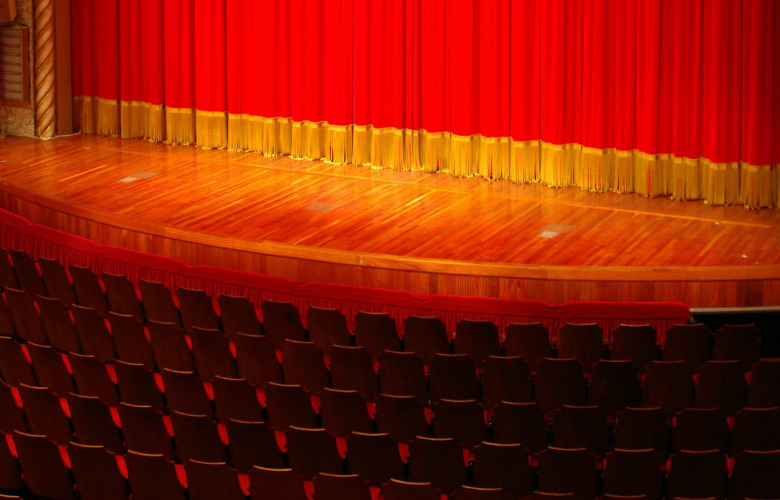
10 strange theatre terms. In this fun little immersion into the weird and beloved world of theatre we only look at 10 such terms and what they stand for. There are of course many more terms as most of you will know. But let’s start with these. And then, perhaps, at some later time, we’ll look at a few others as well. To get you started… have you ever heard of Sitzprobe?
This term comes from the German language and literally translated means “seated rehearsal.”
This does not necessarily mean that everyone will be seated during these rehearsals, but the performers will not move around.
For example, for musicals in which there is a live orchestra (which is most of them), it is important to have rehearsals during which the performers on stage and the musicians in the orchestra pit can go through the entire show to become synchronized with each other.
During these rehearsals there are no costumes. There is no blocking. And there is no set. The focus is entirely on the music and singing.
Sounds almost a bit sinister, doesn’t it?
However, the meaning behind the word is simply “the line that separates the stage and the audience.”
So, most traditional theatre stages have a classic proscenium. Whereas for other stage configurations like arena stages or theatres in the round the actual line is not so clear.
It’s a form of drapery in the theatre. They became popular in the 19th century.
A cyclorama is a large, full-stage drape at the back of the stage. Cycloramas can be curved or have ends that wrap around to create an endless looking background.
Most of the times, the cycloramas are lit to create a sky or a background color of a specific mood.
Legs and borders are a different kind of theatre drapery. They are primarily used to mask or block spaces from the audience’s view.
They are hung parallel to and behind the proscenium. The legs frame the acting space. They create different alleyways for things to happen off-stage. While legs are hung to the right and left off the stage, borders are a type of curtain that hangs from above.
Borders span the width of the stage and are short. Like all drapery they are also fire-proof. And they are used to hide equipment and lighting that is above the stage from the audience.
If these legs and borders are made from materials other than drapery, they are referred to as “hard masking.”
The wings are the most interesting part of any theatre. Well, at least in my opinion. It is where all the action happens that the audience cannot see.
Found on the left and right-hand side of the stage, wings are spaces that can vary in size and shape.
In the wings, the actors prepare to enter the stage. Set pieces are being made ready. There are quick changes. And often a lot of technical equipment can be found in the wings as well.
A ghost light is linked to superstition and is kept on whenever the theatre is empty until someone returns to backstage.
The ghost light does have the practical use of providing at least a little bit of light during the dark so someone walking around backstage in the empty theatre wouldn’t break their legs or necks.
But the ghost light is also on at all times when no show is performed and everyone is gone so devious spirits cannot find their way backstage.
It is a placeholder, keeping watch and protecting the theatre until its cast and crew return for yet another dazzling performance.
Yet another theatre term that originates from the German language.
Basically, there are two kinds of dramaturgy:
There is the Production Dramaturg. A person who works with the company during rehearsals on a pre-existing play. This kind of dramaturg researches information which is important to the play and its context.
Then there is the New Play Dramaturg. This person works with the playwright during the development of the original material. He or she supports the playwright through pointed, constructive questions, workshops, etc.
No, it’s not one of those fun things you played on as a child, flying as high as you could.
In the world of theatre technicians as well as performers, a swing is someone who is capable of filling more than one role backstage or onstage.
For performers you might also call them understudies. They can pitch in when someone falls ill and take over straight away.
But normally, what we call an understudy can only fill in for one of the lead roles, whereas a swing can fill in for a whole number of roles.
In the world of technicians, a swing will be someone who can run more than one track backstage, even across different departments.
In performances which include fight choreography, the actors will gather for a fight call before the performance.
They will go over all the movements. They might go over notes from the previous night, and they will go through all the movements together. To make sure they are all on the same page, and so that no one will get hurt during the performance.
Fight calls can happen for things as small and seemingly insignificant as a slap between two quarrelling characters. Or there can be actual fight scenes which involve the entire cast.
At the end of the day, the goal is to make the fights on stage look as real as possible while doing as much as possible to prevent real injuries to the cast.
This term originates in the Greek language and means “revolving.”
Periaktois are triangular shaped pieces of scenery with different images or locations painted on each side. They are one of the easiest and most cost-effective ways to change a set.
Typically, three to four Periaktois are arranged side-by-side to create one large image.
Then, on cue, stagehands and/or actors will spin them around to create the right image for the next scene.
Storytelling Can Change Lives – Musings of a Transgender Man
Don’t Wear That Hat: Theatre Superstitions and Their Origins


Liam Klenk was born in Central Europe and has since lived on four continents. Liam has always been engaged in creative pursuits, ranging from photography and graphic design, to writing short stories and poetry, to working in theatre and shows. In 2016, Liam published his first book and memoir, 'Paralian'.
Read Full Profile© 2021 TheatreArtLife. All rights reserved.

Thank you so much for reading, but you have now reached your free article limit for this month.
Our contributors are currently writing more articles for you to enjoy.
To keep reading, all you have to do is become a subscriber and then you can read unlimited articles anytime.
Your investment will help us continue to ignite connections across the globe in live entertainment and build this community for industry professionals.